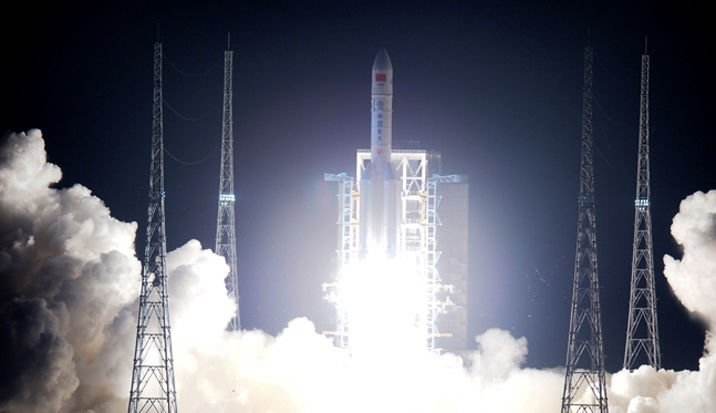In a newly released White Paper — “China’s Space Activities in 2016” — China reviews the achievements of its space industry since publication of the previous White Paper five years ago.
The document comes at the end of a year in which China achieved a record total of 21 launches, including the successful maiden flights of the Long March 5 heavy-lift launcher and the smaller Long March 7. The past year also saw the launch and in-orbit assembly of the Tiangong-2 space laboratory and Shenzhou-11 manned spacecraft.
A section of the document, titled Major Tasks for the Next Five Years details future Chinese space ambitions. Key projects include :
• Space transport system. China plans to develop and launch medium-lift launch vehicles which are non-toxic and pollution-free, improve the new-generation launch vehicle family, and enhance their reliability. China will conduct research into the technologies for low-cost launch vehicles, new upper stage and the reusable space transportation system between the earth and low-earth orbit.
• Space infrastructure. The goal is to improve satellite systems and their basic related items, develop the three major satellite systems (remote-sensing; communications and broadcasting; navigation and positioning) and build a space-ground integrated information network.
• Manned spaceflight. China plans to launch the Tianzhou-1 cargo spacecraft to dock with the earth-orbiting Tiangong-2 space laboratory, and research and master key technologies for cargo transport and replenishment to accumulate experience in building and operating a space station. The aim is to complete the main research and development work on the space station modules, and start assembly and operation of the space station.
• Deep-space exploration. China will continue its lunar exploration project, and strive to attain the automated extraterrestrial sampling and returning technology by space explorers. The goal is to fulfill the three strategic steps of "orbiting, landing and returning" for the lunar exploration project by launching the Chang' e-5 lunar probe by the end of 2017 and realizing regional soft landing, sampling and return. China plans to launch the Chang'e-4 lunar probe around 2018 to achieve mankind's first soft landing on the far side of the moon, and conduct in situ and roving detection and relay communications at earth-moon L2 point. China also intends to execute its first Mars exploration operation, and grasp key technologies for orbiting, landing and roving exploration. It plans to launch the first Mars probe by 2020 to carry out orbiting and roving exploration.
Another section of the report is dedicated to international exchanges and cooperation. It underlines the 43 space cooperation agreements or MoUs signed with 29 countries, space agencies and international organizations since 2011. These include bilaterial agreements with Russia, the U.S. and the European Space Agency, as well as with France, Germany, Italy, Britain and the Netherlands.
The White Paper states that China will, “with a more active and open attitude”, conduct extensive international exchanges and cooperation concerning space in a number of key areas, including:
- Belt and Road Initiative Space Information Corridor, including earth observation, communications and broadcasting, navigation and positioning, and other types of satellite-related development;.
- BRICS remote-sensing satellite constellation.
- Moon, Mars and other deep space exploration programmes and technical cooperation.
- Research and development of a space science satellite, a remote-sensing satellite, payloads, etc.
- Satellite applications, including earth observation, communications and broadcasting, navigation and positioning.
- Space debris monitoring, early warning, mitigation and protection.

